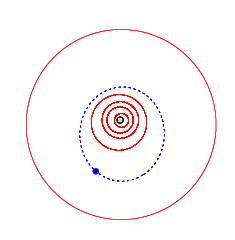10000 Myriostos
|
| |
| Discovery | |
|---|---|
| Discovered by | A.G. Wilson |
| Discovery date | 30 September 1951 |
| Designations | |
| 1951 SY, 1980 TS2[1] | |
| main belt | |
| Orbital characteristics[1][2] | |
| Epoch 13 January 2016 (JD 2457400.5) | |
| Uncertainty parameter 0 | |
| Observation arc | 23542 days (64.45 yr) |
| Aphelion | 3.3756347 AU (504.98776 Gm) |
| Perihelion | 1.8015637 AU (269.51009 Gm) |
| 2.5885992 AU (387.24893 Gm) | |
| Eccentricity | 0.3040391 |
| 4.16 yr (1521.2 d) | |
| 167.11683° | |
| 0° 14m 11.941s / day | |
| Inclination | 20.639592° |
| 169.52023° | |
| 200.18281° | |
| Earth MOID | 0.80725 AU (120.763 Gm) |
| Jupiter MOID | 2.09942 AU (314.069 Gm) |
| Jupiter Tisserand parameter | 3.268 |
| Physical characteristics | |
| Dimensions | ~3 km |
| 15.2 | |
|
| |
10000 Myriostos is a main-belt asteroid discovered by A. G. Wilson on 30 September 1951 at the Palomar Observatory on Palomar Mountain, California.
It was initially provisionally designated as 1951 SY and later named "(10000) Myriostos" (Greek for "ten thousandth") to honor all astronomers who helped discover ten thousand such bodies.[3] This occurred after some debate as to whether Pluto should have been reclassified as a minor planet and given the number 10000, with strong resistance coming from the American Astronomical Society's Division for Planetary Sciences.[4][5]
References
- 1 2 "10000 Myriostos (1951 SY)". JPL Small-Body Database. NASA/Jet Propulsion Laboratory. Retrieved 8 April 2016.
- ↑ AstDys
- ↑ MPC 34632 Minor Planet Center
- ↑ Guy M Hurst (20 June 1999). "THE ASTRONOMER Electronic Circular No 1420".
- ↑ D. Tholen (December 1999). "Asteroid News Notes". The Minor Planet Bulletin. 26: 34, 35. Bibcode:1999MPBu...26...33T.
External links
This article is issued from Wikipedia - version of the 9/9/2016. The text is available under the Creative Commons Attribution/Share Alike but additional terms may apply for the media files.
